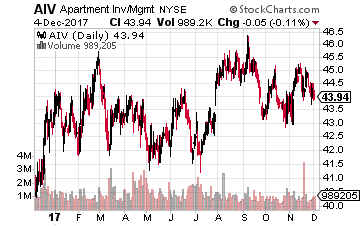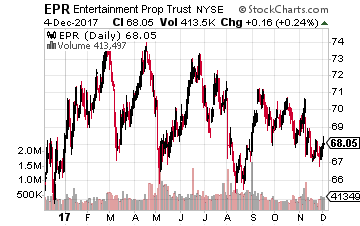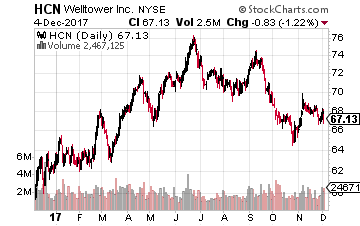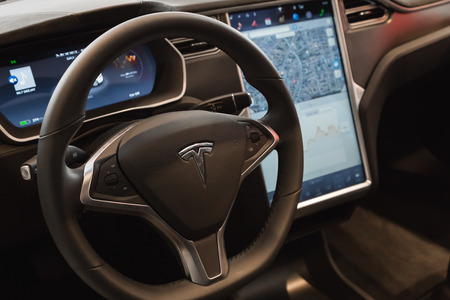To build momentum from your income stocks going into the new year, consider buying into those REITs that should announce higher dividend rates in the first month of 2018. Each month I like to list those real estate investment trusts (REITs) that should announce higher dividend rates in the upcoming months. This knowledge can give you a jump on the rest of investing public, which will be surprised when the positive news is announced.
I maintain a database of about 130 REITs. With it I track current yields, dividend growth rates and when these companies usually announce new dividend rates. Most REITs announce a new dividend rate once a year, and then pay that rate for the next four quarters. Currently about 90 REITs in my database have recent and ongoing histories of dividend growth. Out of that group, higher dividend announcements will come from different REIT companies during almost every month of the year. With the potential of a Fed interest rate hike, the prospects of higher dividend payments coming in January will help to offset any share price disruptions resulting from announcements out of the Federal Reserve Board.
Related: Add This Unique REIT to Your Portfolio for Dividend Safety
My list shows three companies that historically announce higher dividends in January and should do so again this year. Investors will start earning the higher payouts in the new year. But remember, you want to buy shares before the dividend announcement to get the benefit of a share price bump caused by the positive news event. Here is the list of REITs to consider:
 Apartment Investment and Management (NYSE: AIV) is a mid-cap sized REIT that owns and operates about 140 apartment communities. About 40% of the company’s properties are in coastal California, with the balance spread across major U.S. metropolitan areas. Last year, AIV increased its dividend by 9.0%. Cash flow growth has been comparable in 2017, and I forecast an 8% to 10% dividend increase in January. The new dividend rate announcement will come out in late January with a mid-February ex-dividend date and payment at the end of February. AIV yields 3.3%.
Apartment Investment and Management (NYSE: AIV) is a mid-cap sized REIT that owns and operates about 140 apartment communities. About 40% of the company’s properties are in coastal California, with the balance spread across major U.S. metropolitan areas. Last year, AIV increased its dividend by 9.0%. Cash flow growth has been comparable in 2017, and I forecast an 8% to 10% dividend increase in January. The new dividend rate announcement will come out in late January with a mid-February ex-dividend date and payment at the end of February. AIV yields 3.3%.
 EPR Properties (NYSE: EPR) focuses its real estate investments in three different business sectors. Primary is the ownership and triple-net leasing of entertainment complexes and multiplex theaters. The second sector is the ownership of golf and ski recreation centers, also triple-net leased. The third sector is the construction, ownership and leasing of private and charter schools. EPR pays monthly dividends, and has grown the dividend rate by an average of 7% per year for the last six years. In 2017 the company was active in both acquisitions and new developments. The new dividend rate is announced in mid-January, with an end of January record date and mid-February payment. EPR currently yields 6.0%.
EPR Properties (NYSE: EPR) focuses its real estate investments in three different business sectors. Primary is the ownership and triple-net leasing of entertainment complexes and multiplex theaters. The second sector is the ownership of golf and ski recreation centers, also triple-net leased. The third sector is the construction, ownership and leasing of private and charter schools. EPR pays monthly dividends, and has grown the dividend rate by an average of 7% per year for the last six years. In 2017 the company was active in both acquisitions and new developments. The new dividend rate is announced in mid-January, with an end of January record date and mid-February payment. EPR currently yields 6.0%.
 Welltower Inc (NYSE: HCN) is a large cap healthcare sector REIT. The company owns interests in properties concentrated in markets in the United States, Canada and the United Kingdom. The portfolio is divided into three segments consisting of: Seniors housing and post-acute communities, and outpatient medical properties. Triple-net properties include independent living facilities, independent supportive living facilities, continuing care retirement communities, assisted living facilities, care homes with and without nursing, Alzheimer’s/dementia care facilities, long-term/post-acute care facilities and hospitals. Outpatient medical properties include outpatient medical buildings. Welltower has increased its dividend every year since 2009, with a modest 1.2% increase to start 2017. I expect a 2.0% to 2.5% increase to be announced in January. The announcement will come out at the end of the month, with an early February record date and payment around February 20. The stock yields 5.1%.
Welltower Inc (NYSE: HCN) is a large cap healthcare sector REIT. The company owns interests in properties concentrated in markets in the United States, Canada and the United Kingdom. The portfolio is divided into three segments consisting of: Seniors housing and post-acute communities, and outpatient medical properties. Triple-net properties include independent living facilities, independent supportive living facilities, continuing care retirement communities, assisted living facilities, care homes with and without nursing, Alzheimer’s/dementia care facilities, long-term/post-acute care facilities and hospitals. Outpatient medical properties include outpatient medical buildings. Welltower has increased its dividend every year since 2009, with a modest 1.2% increase to start 2017. I expect a 2.0% to 2.5% increase to be announced in January. The announcement will come out at the end of the month, with an early February record date and payment around February 20. The stock yields 5.1%.
Any one of these three stocks would be a great addition to your dividend growth portfolio. You see, it’s not just important to include high-yield stocks that give you income now, but to hold stocks with a strong history of growing their dividend year after year. It’s like getting a raise every… that you didn’t have to ask the boss for.
These are the same kinds of stocks that I recommend as a core part of my high-yield income system called the Monthly Dividend Paycheck Calendar. It’s a system used by over 6,000 income investors right now to produce average monthly paydays upwards of $4,000 in extra income. And it’s helped to solve a lot of income problems and retirement worries.
Quality REITs need to be a core component to your income portfolio. Not only do you get the high yields but you also enjoy rising dividends and as we’ve seen from historical examples, share price gains as an added bonus. There are several best in class REITs in the portfolio of my Dividend Hunter service which features the Monthly Dividend Paycheck Calendar.


